This Sri Lankan Jackfruit Curry is packed with so much flavor, you won’t even realize it’s meatless! This curry is perfect for vegetarians, vegans, and gluten free diets, or anyone who loves a kick ass curry for that matter!
Learn how to make classic Sri Lankan Jackfruit Curry
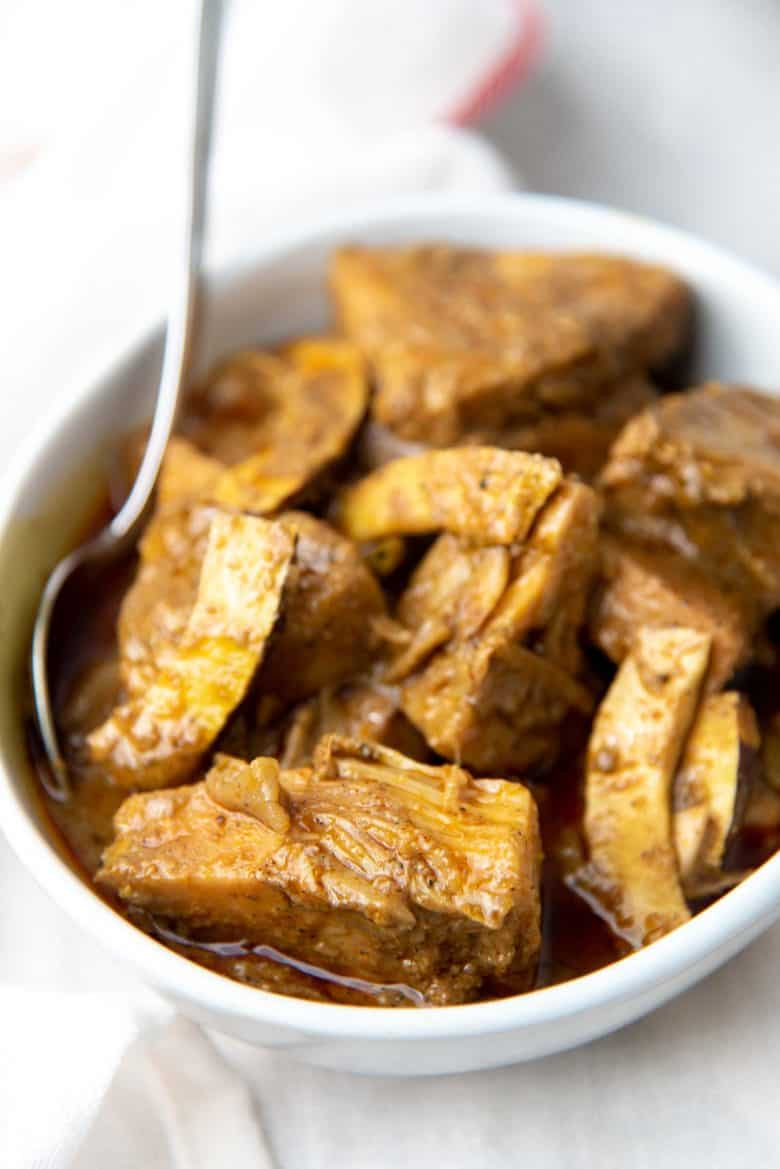
Jackfruit is a unique fruit because of its meaty texture. In recent years it’s become VERY popular in western diets not only because of its nutritional content, but also because it’s an incredible faux meat substitute for dishes like BBQ pulled pork.
In Sri Lanka (and many other Asian countries), jackfruit is a big part of the diet. The fruit is known for its amazing versatility. It’s edible at every stage of its life, and there are different sinhalese names for each stage of the fruit.
- The whole fruit is called “kos” (කොස්).
- Unripe jackfruit (young jackfruit or green jackfruit) is treated as a vegetable. This is called “polos” (පොලොස්).
- Ripe, sweet jackfruit is delicious and eaten raw as a fruit. This is called “varaka” (වරකා).
Today I’m going to share my step by step AUTHENTIC Sri Lankan jackfruit curry recipe, using canned young jackfruit!
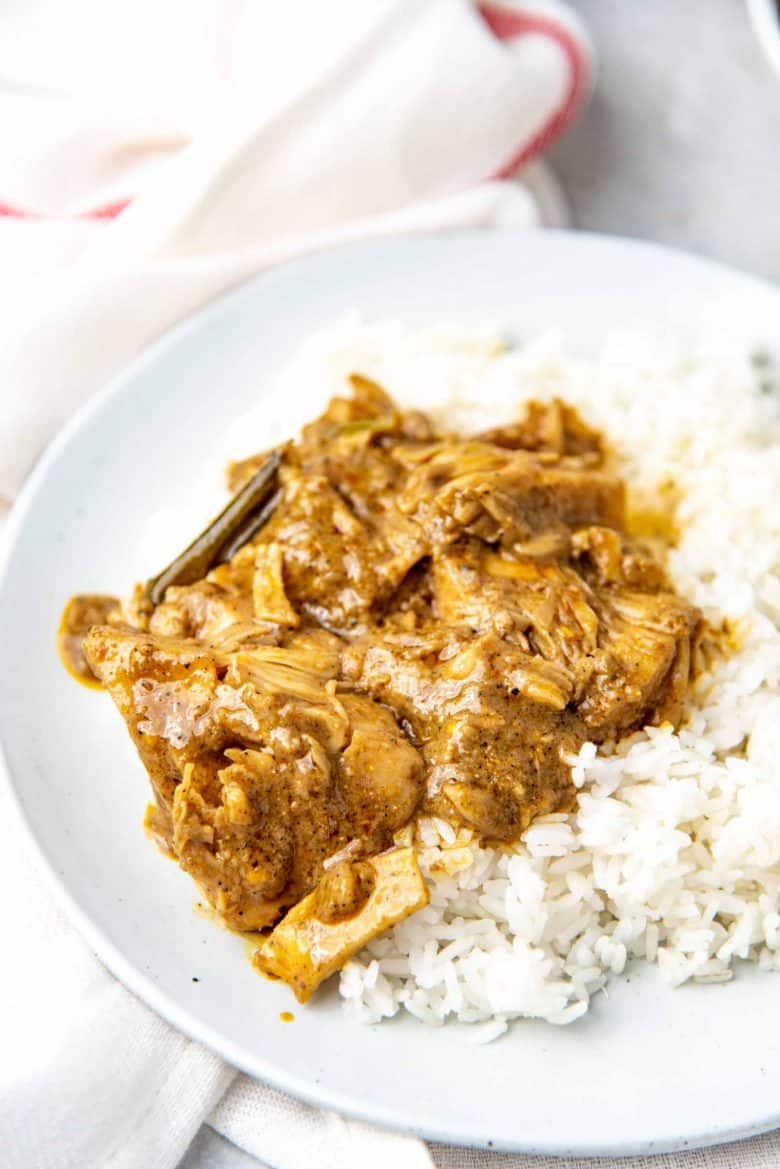
Ingredients needed
Young jackfruit – You can use canned or fresh young jackfruit for this curry recipe. These have very small seeds (or none at all), and very little fruit. It’s mostly the petals. Here I’m using my favorite brand of canned jackfruit.
Coconut milk – A good brand of full fat coconut milk. It’s what makes this curry creamy. You can go with light coconut milk or powdered coconut milk too, but I prefer regular coconut milk.
Sri Lankan curry powder – I use my own curry powder recipe for this. You can use store-bought Sri Lankan curry powder, or Madras curry powder for a fairly similar option. Honestly I’ve NEVER bought curry powder though, because to be perfectly frank, my homemade curry powder blows any store-bought curry powder out of the water. The homemade version simply tastes heaps better. My curry powder recipe is also quite flexible, so go ahead and check it out and make some for yourself too. Do avoid using garam masala for this recipe.
Tamarind – This is an essential ingredient that adds a lovely fruity sourness to the curry. You can use fresh of course, but you can also buy tamarind paste and/or concentrate from most Asian stores too. So, I have provided amounts for both the paste and the concentrate in the recipe.
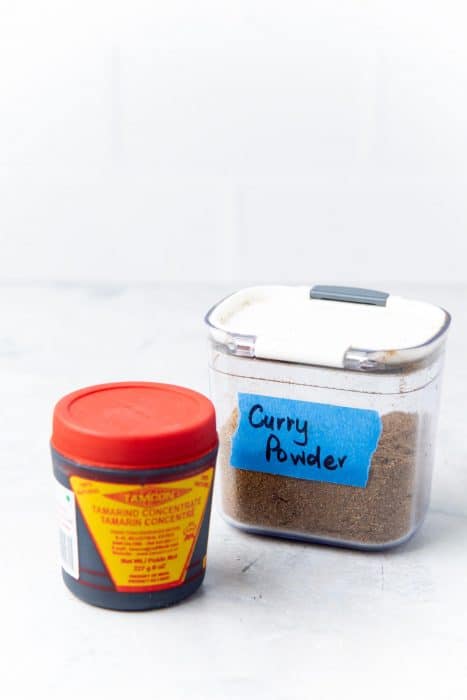
Spices
Curry leaves – Curry leaves add a special flavor. You don’t have to add fresh leaves. You can use dried leaves instead. If you can’t find either, just leave them out, or use a bay leaf instead. Do NOT use BASIL, LIME ZEST OR LEMON BALM in their place. These add a different flavor altogether and taste weird not just in this jack fruit curry, but any curry.
You can also add pandan leaves (known as rampe or screwpine leaves). The flavor is not the same as that of curry leaves, but will complement the curry quite well.
Cinnamon – If you have Ceylon cinnamon (i.e. Sri Lankan cinnamon; widely known as “true” cinnamon), absolutely use that! It has a more delicate, floral sweetness than Mexican cinnamon. But if you only have regular cinnamon, you can use that in a pinch too (but maybe add a little less).
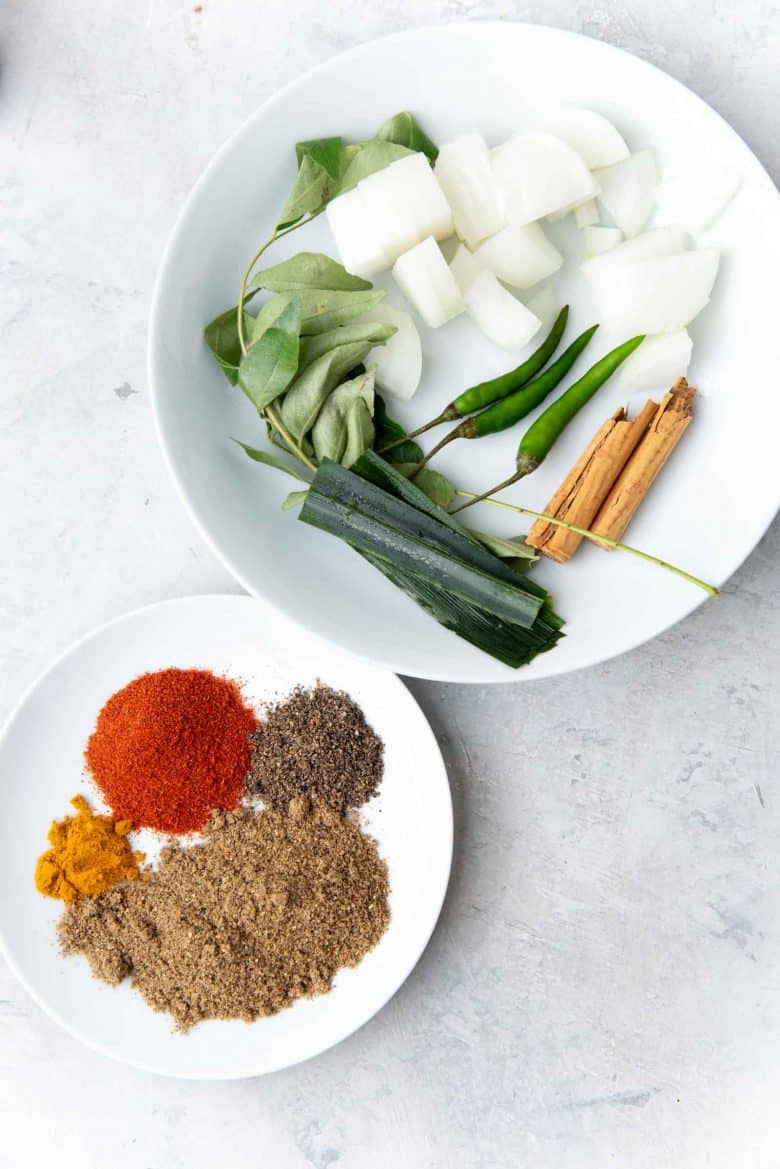
Other spices and ingredients – Garlic and ginger, onion, black pepper, chili pepper, turmeric, cinnamon, and tamarind. The black pepper and chili pepper can and SHOULD be adjusted to your taste. My husband and I LOVE spicy curries, so we add a lot of a heat to our curry. But here I have reduced it to a level that I feel is at a medium heat spice level. But YOU know your preferences best – so be cautious when adding spices to this jackfruit curry.
Coconut pieces – This is an optional ingredient. Growing up, my grandmother and my mother always added coconut pieces to this curry. It adds delicious milky, crunchy element. As a kid, I couldn’t get enough of it!
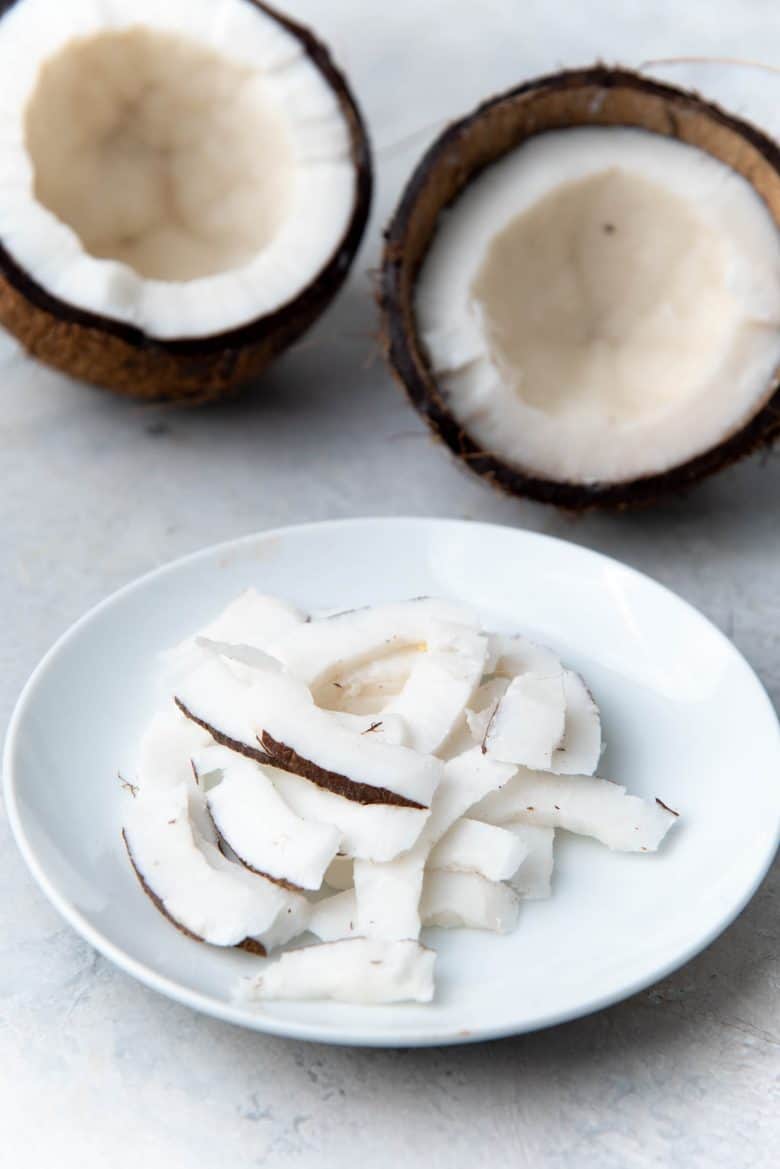
Tips on how to perfect this jackfruit curry
In theory, you can dump ALL the ingredients into a pot, and then let them simmer. Really, it works (curries are very forgiving). BUT ideally, you want to get the MOST flavor out of all of these ingredients. So take your time and layer those spices and flavors.
Use coconut oil if you can. It adds more flavor. If not, just use a type of cooking oil that you prefer.
Soften the onions, and add the spices to the hot pan. The hot pan and oil will further toast the curry powder, deepening the flavor of the spices. Be careful not to burn the spices though!
This curry braises the jackfruit. The braising can go for about 1 – 2 hours. My happy medium is 1 1/2 hours. The result is incredibly tender pieces of jackfruit that soak up all the flavors in the curry like a sponge. Not only are the petals soft and yielding, but the “nose” of the jackfruit that is usually hard, will also be very soft and meaty.
You can use your instant pot or pressure cooker to speed up the cooking process if you like. But since there’s no water evaporation, the resulting gravy will be very watery. So adjust the liquid level to prevent this from happening.
Once the jackfruit is braised in the curry, it’ll be very soft! So when you have to mix your jackfruit curry, do so very carefully. Otherwise, you may end up shredding the jackfruit. Still delicious, but not quite the curry masterpiece you were hoping for!
Have leftovers? No problem. You can make jackfruit kottu roti, using this chicken kottu roti recipe. Simply substitute the chicken with the leftover jackfruit.
How to serve Sri Lankan jackfruit curry
You can serve this any way you like to serve curry! With rice and other vegetarian side dishes is a great way to serve this jackfruit curry for a completely plant based meal. But you can serve it with proteins too.
If not rice, you can also serve this curry with roti, like this authentic Sri Lankan coconut roti.
I also usually pair this with Sri Lankan Pol Sambol (like a chili coconut relish), which is also really popular in Sri Lanka.
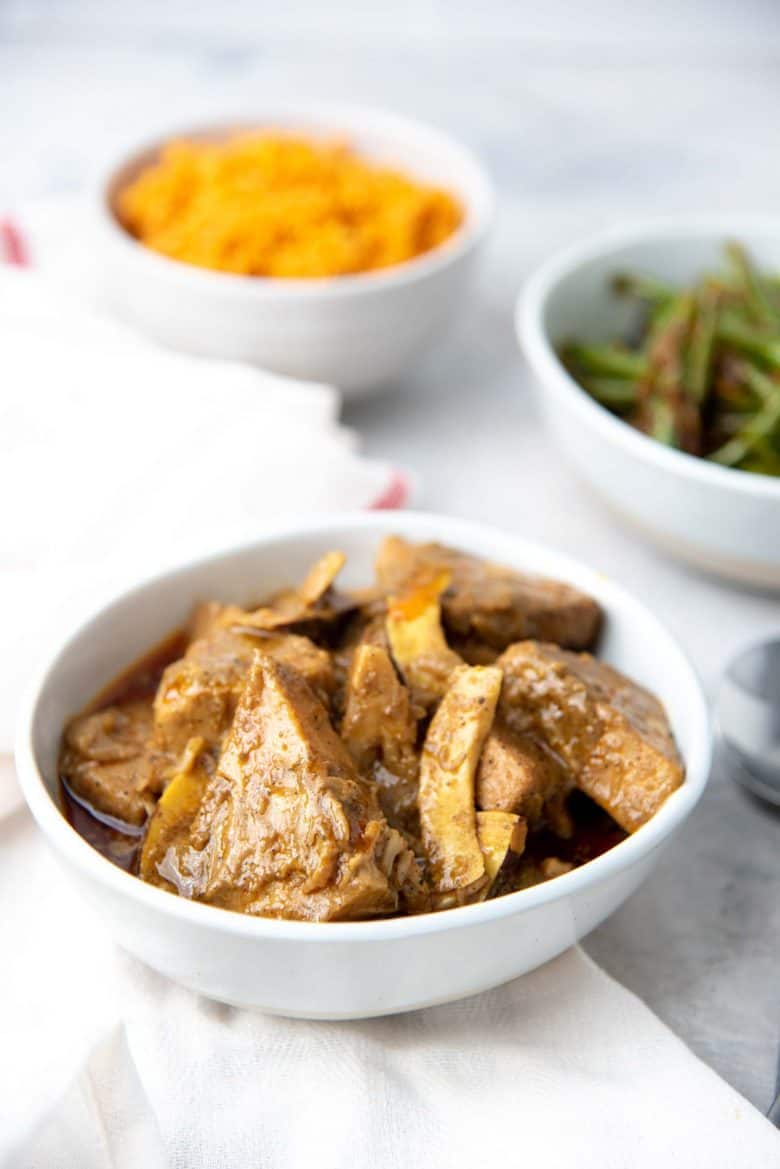
Can I use fresh jackfruit to make this curry?
Yes! Just make sure to use young jackfruit, which is also known as green jackfruit.
Unfortunately, I don’t have access to fresh jackfruit where I live now. So we rely on canned jackfruit for this curry.
Young jackfruit is conveniently sold in a can with brine, and can easily be used to make jackfruit recipes. It’s great quality, so you don’t have to worry about the final result. It’ll be pretty darn authentic.
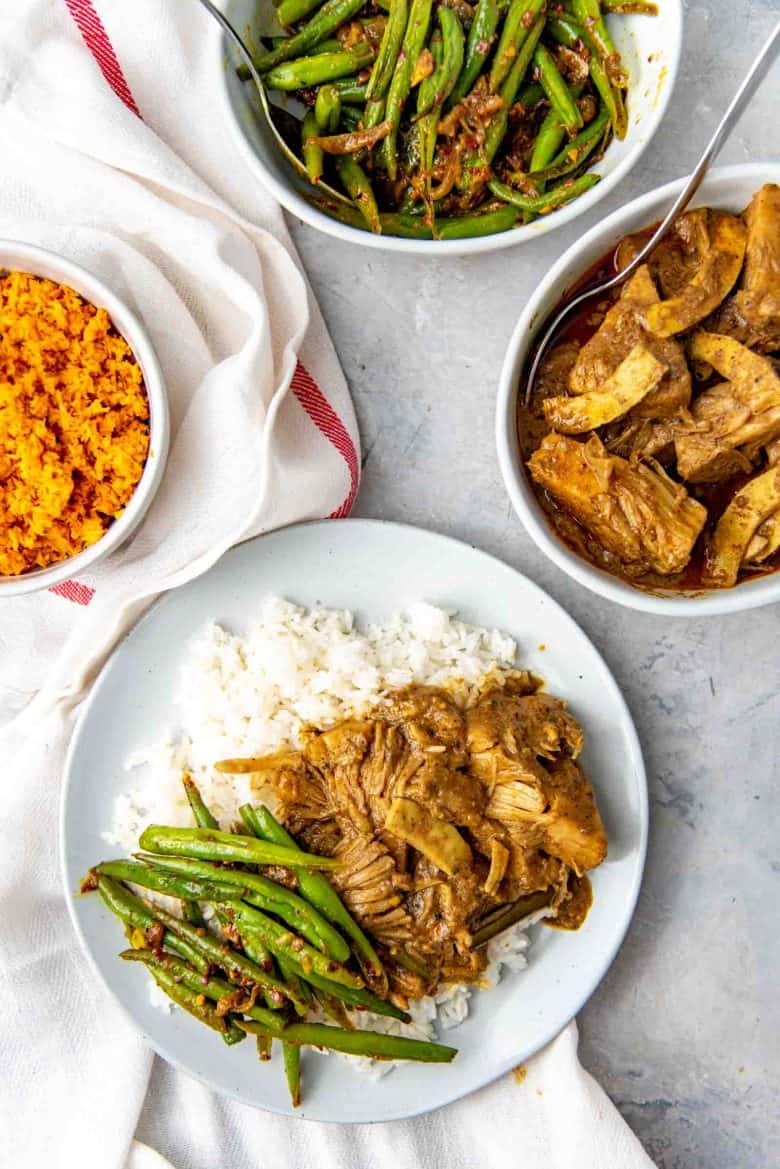
What other dishes can you make with jackfruit?
- Kiri kos – A jackfruit curry made with young jackfruit and coconut milk. Not spicy, but very creamy and flavorful.
- Classic Sri Lankan polos curry – The recipe that I’m sharing here. It’s a little sour, with more spices (but doesn’t have to be spicy), and creamy as well. Some prefer a drier preparation of this curry.
- Boiled kos – Jackfruit that is not quite young, but not ripe yet either. The jackfruit is steamed until tender (seeds as well) and served with fresh coconut and Sri Lankan chili sambol (lunu miris).
- Polos mallum – Young jackfruit that’s shredded and cooked with shredded coconut and spices. This preparation is a dry dish (no gravy).
- Varaka – Sweet and ripe jackfruit. Can be eaten raw, and my favorite way to eat jackfruit. Nothing but sweet, juicy deliciousness.
- Jackfruit seeds – Jackfruit seeds are edible too! These can be roasted as a snack, or even cooked as a curry (Kos ata maaluwa).
As you can see, the versatility of jackfruit is off the charts. It’s an absolute favorite in every Sri Lankan household, and I’m sure you will love it too! 🙂
Looking for more recipes?Sign up for my free recipe newsletter to get new recipes in your inbox each week! Find me sharing more inspiration on Pinterest and Instagram.
Sri Lankan Jackfruit Curry (Polos Curry)
Ingredients:
- 2 tbsp coconut oil or any cooking oil
- ½ medium onion or shallots
- 2 - 3 garlic cloves minced or whole
- 1 inch piece of ginger minced
- 10 curry leaves you can use as little as 5 as well
- 2 pandan leaves about 2 inches in length
- 2 tbsp Sri Lankan Roasted Curry Powder
- 1 tsp cayenne pepper adjust chili to your spice level
- ½ tsp ground turmeric
- 1 tsp black pepper use bout ½ tsp if you prefer less spice
- 1 cinnamon stick about 4 inches
- 1 tsp tamarind concentrate 1 tbsp tamarind paste
- 1 ¼ tsp sea salt
- 1 tsp sugar from a measuring spoon, not a regular spoon
- 600 g canned jackfruit from 2 cans, rinsed and drained
- Coconut pieces optional
- ¼ cup water
- 1 ¼ cup coconut milk avoid lite coconut milk
- Salt to taste
Instructions:
- In a medium sized saucepan, heat the coconut oil over medium heat.2 tbsp coconut oil
- When the oil is heated, add the onion, and saute until softened.½ medium onion
- Add the garlic and ginger, and saute for a few minutes, but make sure not to let them burn. If you’re using whole garlic cloves, these will soften during the cooking process too.2 - 3 garlic cloves, 1 inch piece of ginger
- Add the curry leaves and pandan leaves, and let them fry in the oil for just a few seconds.10 curry leaves, 2 pandan leaves
- Add the curry powder, cayenne pepper, turmeric, black pepper, and cinnamon stick, and saute the mixture for about 1 - 2 minutes to mix. The spices should be very fragrant, but again, make sure not to let them burn. Adjust the stove heat accordingly.2 tbsp Sri Lankan Roasted Curry Powder, 1 tsp cayenne pepper, ½ tsp ground turmeric, 1 tsp black pepper, 1 cinnamon stick
- Next, add the tamarind, salt, sugar, young jackfruit, and coconut pieces (optional), and mix to coat the jackfruit in the spice mix.1 tsp tamarind concentrate, 1 ¼ tsp sea salt, 1 tsp sugar, 600 g canned jackfruit, Coconut pieces
- Add the water and coconut milk, and stir to mix. Increase the heat to medium high and bring the curry to a boil.¼ cup water, 1 ¼ cup coconut milk
- Lower the heat to medium low to low, and let the curry gently simmer (with the lid slightly off) for about 1 - 1 ½ hours. If too much liquid is evaporating while cooking, add some water as needed.
- The jackfruit pieces should be nice and soft (check by pricking the “nose” of a jackfruit piece to see how easily it can be pierced with a knife/fork or skewer). Taste and season with salt to taste.
- After the curry has simmered and the jackfruit is soft, you can cook the curry uncovered for a few more minutes IF you prefer a thicker curry gravy. If the gravy is too thick for your liking however, add a little water. Always season to taste.Salt to taste
- Serve the curry warm. But as with any curry, they do taste even better the following day!
Tips & Tricks
Storage instructions
This curry can be stored in an air tight container and be stored in the fridge for about 4 days. However, practice clean and safe food practices like,- using clean spoons
- not leaving it out of the fridge for long periods of time
- Avoid reheating and refrigerating repeatedly - only take what you need and reheat that.
- Ideally, store the curry in separate portions, so you can easily use what you need at a time.
Nutrition Information:
“This website provides approximate nutrition information for convenience and as a courtesy only. Nutrition data is gathered primarily from the USDA Food Composition Database, whenever available, or otherwise other online calculators.”
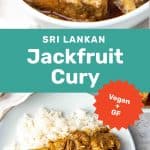
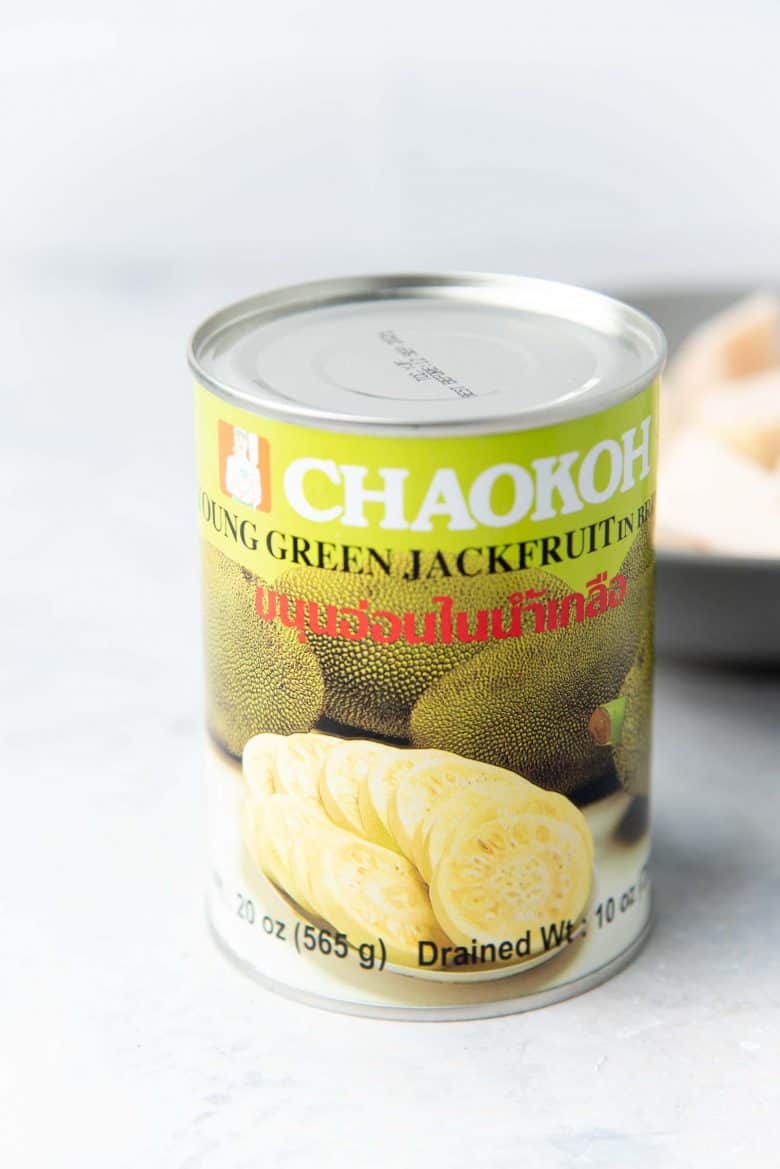
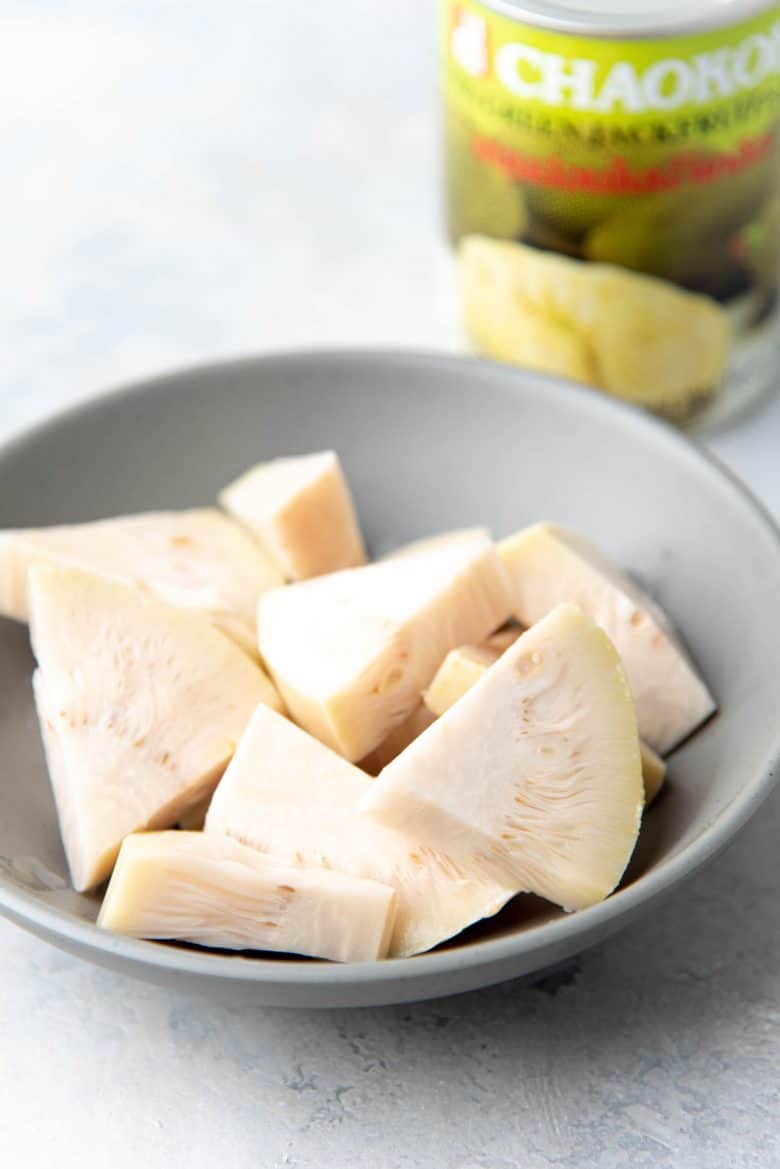
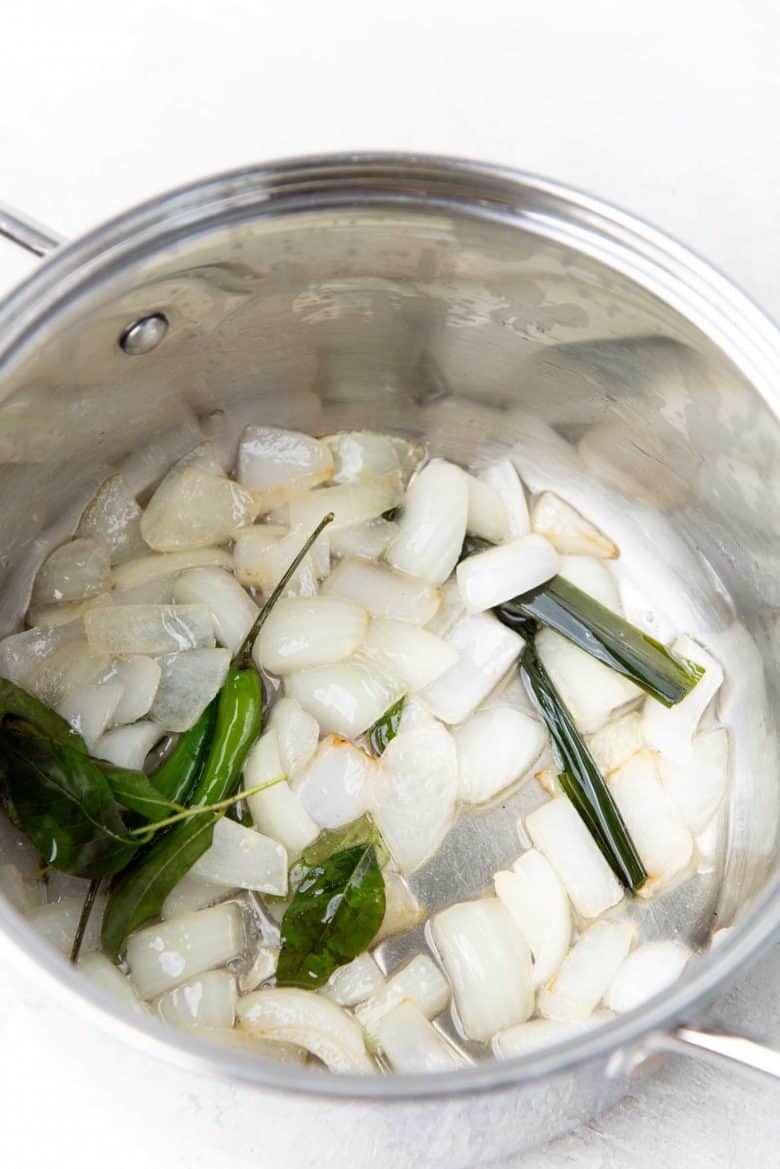
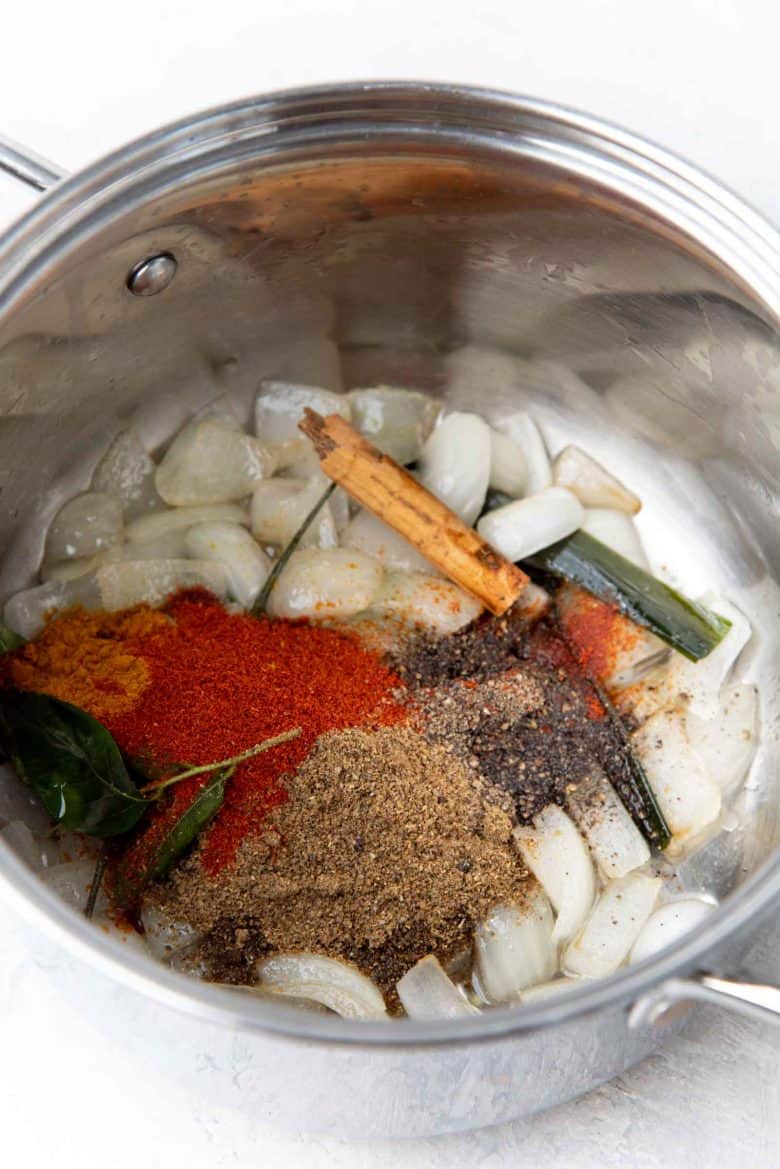
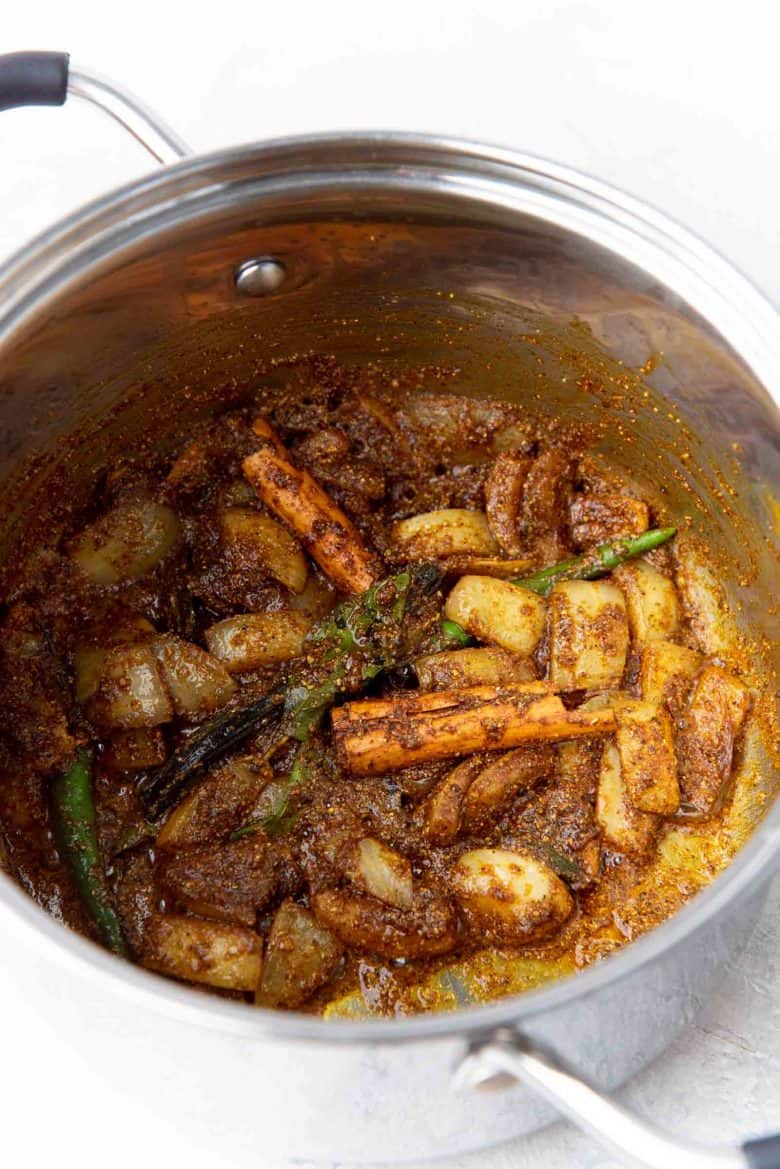
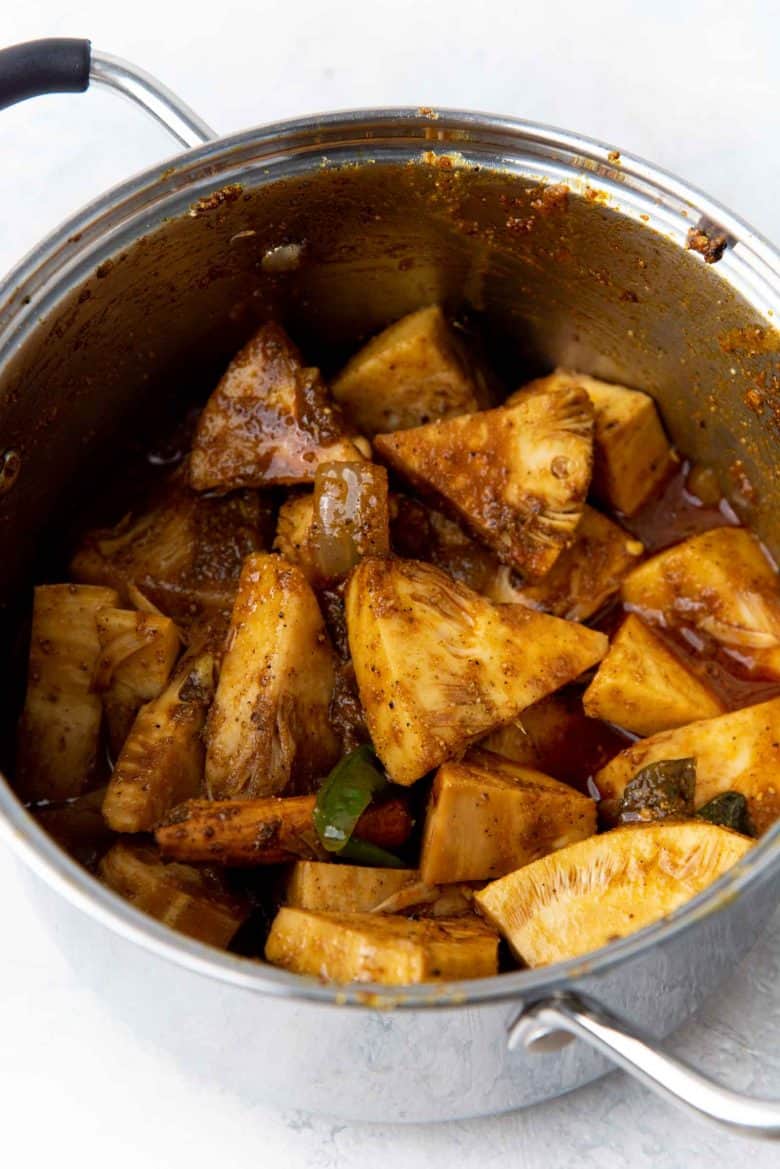
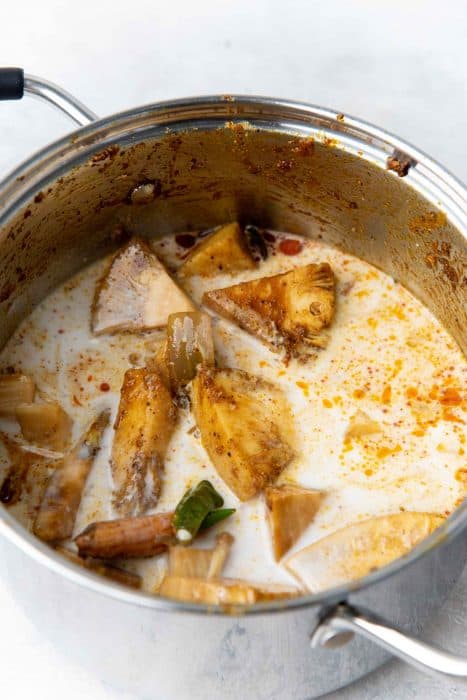
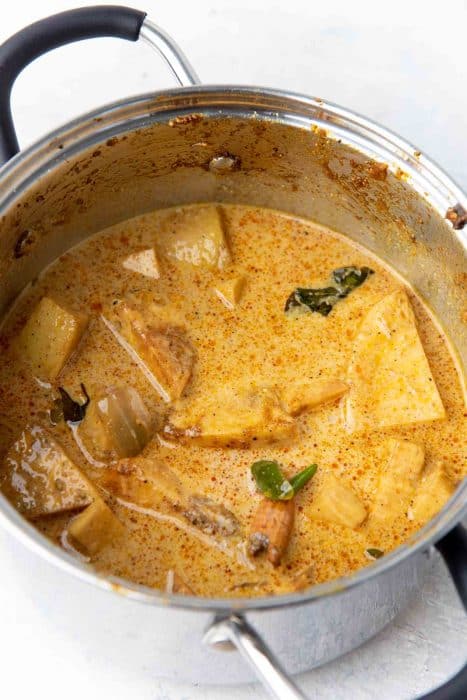
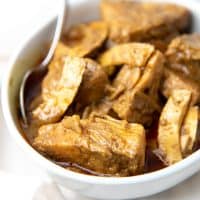
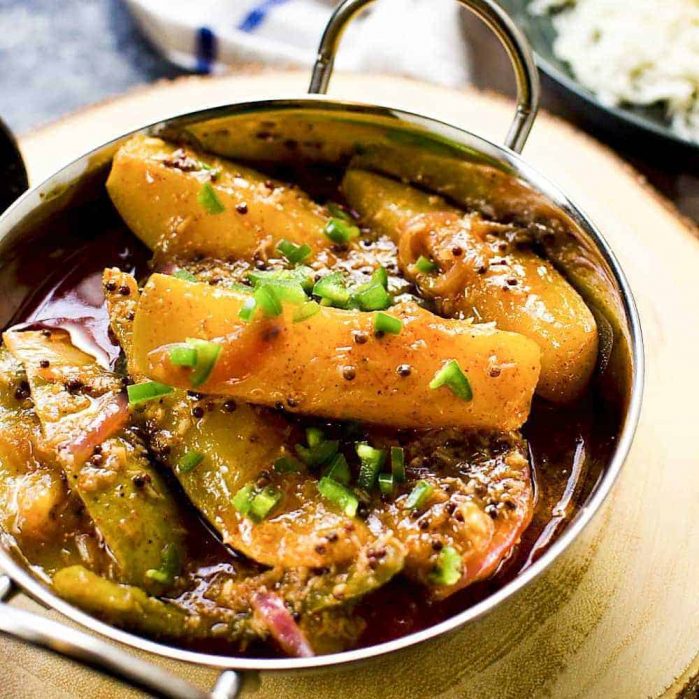
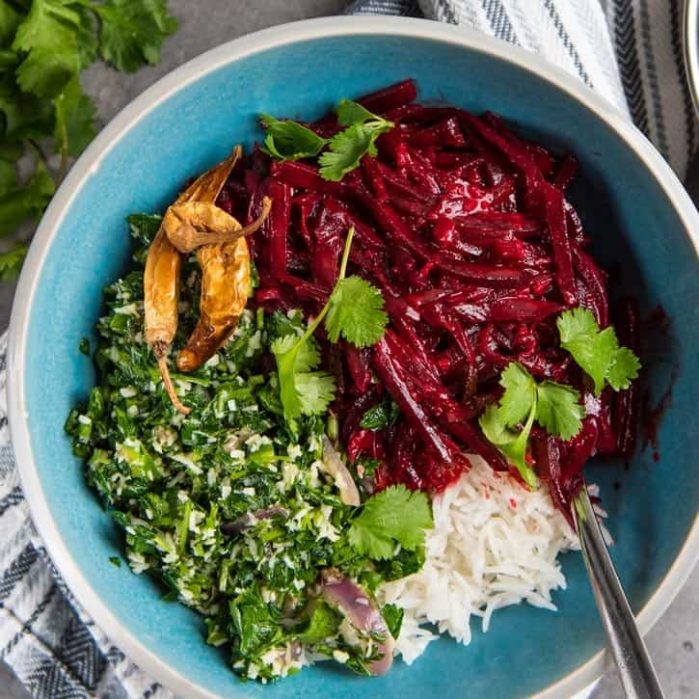
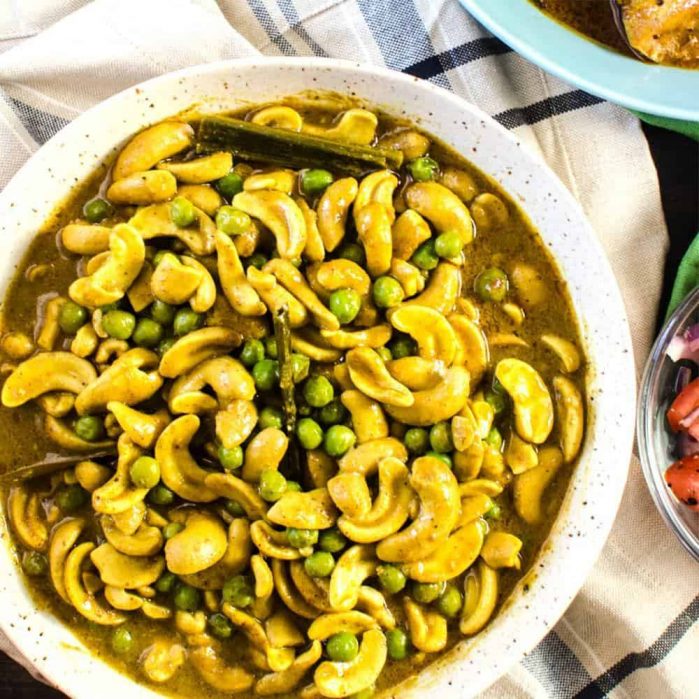
Elizabeth Hird says
One of the best curries I’ve ever had!
AK says
This is absolutely delicious, and I had great success making it in the instant pot! For anyone else who wants to give that a try: I reduced the water by half (to 1/8c), followed steps 1-7 in the pot in saute mode, then pressure cooked on high for 30 minutes with a 15 minute natural release. There was some extra liquid when I opened it up, so I put it in saute mode for a few minutes to thicken. The jackfruit turned out perfectly tender!
Dini says
Wonderful, thanks so much for letting me know AK! I’m very glad that it worked for you in the instant pot!
B Lee says
Great and simple
Ruchithri Favreau says
I’ve tried numerous jackfruit curry recipes but yours is the only one that hits home. Soo yumm!
Diva says
It was perfect
Chandra says
Good advice and very descriptive.
thusitha kelum says
after two days eat to polos curry its very tasty
Mary says
This dish was so delicious and satisfying. We ate it over brown rice. I did not have all of the spices on hand, but the curry was still very tasty. Would definitely make again.
MW says
Hi Dini, I am a Sri Lankan living in Canada too!! I am not a great cook but I know that some people use “Gorakka” when cooking Pollos Curry. Is it when they cook the fresh Pollos fruit or can Gorraka be substituted for Tamarind ? If so how many pieces?
Another question, what is pandan leaves, is it Rampe ?
Dini says
Hi MW!
Goraka and tamarind both add sourness to curry dishes, so they can be used interchangeably. They have slight flavor differences, like goraka is more earthier, and tamarind has a fruity sourness. Traditionally (at least according to my grandmothers), goraka was more favorable in fish curries and tamarind in meat curries, but like I said, they are interchangeable if only for the sour taste that they impart.
It’s hard for me to let you know how many goraka pieces to add to the curry, as the sourness deepens the longer the goraka is cooked in the curry as well. I would start with maybe 2 pieces and remove it if the sourness is too much.
And yes, rampe leaves are pandan leaves.
Hope that helps!
Jordana S. says
Delicious!!! I used coconut cream instead for a more thicker sauce but the flavor was amazing. A Winner for my vegan family